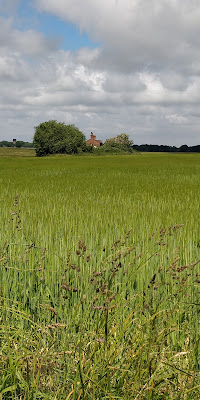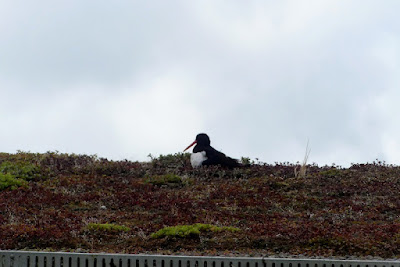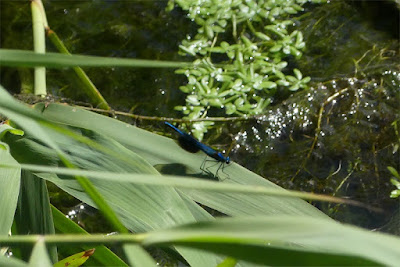 |
| Black-headed gull and heron |
It was threatening to be a pleasant day, though there was still an abiding dampness and that wind had an edge, so I thought I'd get a day out at Martin Mere. I'm feeling a bit shy of waders at the moment, particularly not being able to pick up either green sandpiper nor wood sandpiper along the way, so I decided I'd concentrate on the reedbed hides there today.
The mute swans on the canal in Trafford Park had brought their cygnets to the bridge as the train passed over and there were more cygnets on the lake as we passed Pemberton Park. Wrens, blackbirds and woodpigeons sang at railway stations and the sunshine brought out the roe deer between Lostock Junction and Westhoughton. A sign that the seasons had moved on was the silence of the rookery when I got off the train at Burscough Bridge.
 |
| By Red Cat Lane |
It took a while to walk the stiffness out of joints still complaining about yesterday's weather. Luckily there was plenty of distraction about, whether it was the young starlings clamouring to be fed in the gardens of Burscough or the skylarks singing over the fields by Red Cat Lane. There was plenty about but none of it obvious to the eye. Blackbirds, chaffinches, dunnocks, great tits and robins sang in hedgerows, even one of the house sparrows bustling about between hedgerows and gardens joined in. The greenfinches and goldfinches I picked up by their calls, the silent corn buntings and song thrushes by sheer dumb luck.
I was worried that I hadn't seen any hirundines along the way. That all changed when I got to Curlew Lane. There weren't the usual crowds of swallows and house martins at the farm on the corner but they were a constant presence from there on in. I took a detour down Curlew Lane to look for yellow wagtails. They were all in the wheat field on the corner, striking poses on the tops of ears of wheat and disappearing whenever the camera got them into focus. It was striking how much the yellows and olives of the females' plumage matched the tones of the ripening wheat. The pied wagtails bouncing round the potato store at Brandeth Barn were no more cooperative for the camera.
 |
| On Fish Lane opposite Martin Mere |
 |
| The white storks by the pedestrian entrance to Martin Mere had youngsters in the nest. |
 |
| Oystercatcher |
At Martin Mere I went straight to the Discovery Hide to see what was about. The first thing that I noticed was that the oystercatcher nesting on top of the hide had at least one chick. As did nearly all the black-headed gulls nesting on the mere. And those that hadn't were going the right way for the production of a fresh batch. Greylags had goslings, mallards had ducklings, there were a few shelducks about but I couldn't see that any of them had ducklings. All the avocets, oystercatchers and lapwings feeding on the far bank were adults.
 |
| Black-headed gulls and chicks |
 |
| Mallard duckling |
I'd looked in vain for any Mediterranean gulls, despite there nearly always being at least one pair in the colony. I'd given up on them when a head popped up over the rise of a little island. A pair was nesting just out of sight. The head's partner flew in and disappeared behind the rise. About ten minutes later one or other of them decided to have a walk around the island, which gave me the opportunity to get a photo.
 |
| Mediterranean gull |
 |
| Wigeons |
A quick look at the mere from the viewpoints where the Swan Link used to be was worth the effort, if only for the unseasonal wigeons grazing on the bank. Blackbirds, blackcaps and chiffchaffs sang in the trees on the way to the Janet Kear Hide where reed buntings were making inroads on the seed feeders.
There had been reports of spoonbills on the pond by the United Utilities Hide, apparently I'd just missed the last one.
By now it was a warm, sunny afternoon though still very breezy. The red admirals and large whites kept to the cover of the tree-lined paths in the older parts of the reserve, I didn't see any butterflies out on the reedbeds. I thought I wasn't going to be seeing any dragons or damsels either until I noticed the rear end of a blue-tailed damselfly poking out of the bracken under the bridge over the drain by the Rees Hide. I was surprised by a burst of song and even more surprised to find it was a very brightly plumaged male stonechat doing the singing.
 |
| Stonechat |
 |
| Stonechat |
The pool at the Rees Hide was more than half bone-dry. Over on the far side avocets and their small chicks paddled ankle-deep as they fed. Near by a couple of jackdaws fossicked about in the grass that would have been at the poolside edge. There was an insistent calling that wasn't coming from the avocets. Suddenly a little ringed plover ran up to the jackdaws. When they paid no attention the plover went into its distraction display, tail fanned, wing horribly crooked, an injured bird in obvious pain. The jackdaws' interest was piqued and they followed it as it limped away, flying after it as it fluttered off into the reeds. The plover returned to its nest, I had no idea where it was up to then. Once settled it became invisible, its back the same colour as the mud and from behind the white ring and black cap broke up the shape of the bird and looked like flat stones sitting on the mud. Ironically the jackdaws came back to their fossicking a couple of minutes later.
A field away a few cattle egrets accompanied the grazing longhorn cattle. Most of the time they were invisible, a couple of times they made it easier by riding on the back of one of the bigger animals, the nursing cows weren't happy with them taking any liberties with the calves. A long way in the distance a female marsh harrier was doing a very credible impersonation of a hovering buzzard in the wind with a lot more tail action than you'd see with either a kestrel or a buzzard on the hover.
 |
| Juvenile avocet |
It was a bit damper at the Gordon Taylor Hide and the avocets a lot closer to the hide. There was a variety of avocet chicks ranging from one that would have been about a week old to a couple of three-quarter grown birds in black and white livery with pepper and salt on the back and wings. The parents were in feisty mode, as they always are. One chased a family of ducklings from one far corner of the pool to another, then returned a few minutes later to chase them back again. Their mother got fed up of the game and took her charges into the reeds to swim down the drain. A few black-headed gulls had nests. Every so often the avocets harassed the gulls returning to their nests. And every so often the gulls harassed the avocets for getting too close to their nest and chicks.
 |
| Avocet and black-headed gulls |
 |
| Avocets |
 |
| Avocets |
They all joined in harassing a heron that strolled into the pool and it flew off pursued by black-headed gulls with avocets and lapwings joining in as it passed by.
 |
| Heron |
 |
| Black-headed gull and heron |
A redshank flying in was the only
Tringa sandpiper I saw all day.
 |
| At the Gordon Taylor Hide |
As I left the hide and crossed the drain I spotted a flash of blue. Male banded demoiselles were chasing each other up and down the drain, the black patches on their wings emphasising the fluttering of their flight. A couple of common blue damselflies were keeping out of the wind and away from the demoiselles in the cover of the bankside vegetation.
 |
| Banded demoiselle |
A stroll about the reedbeds added singing reed warblers and Cetti's warblers and a passing four-spotted chaser to the day's tally. I hadn't added any waders to the year list but it was a day list in the sixties.
 |
| Reedbed Walk |
 |
| Walking to New Lane Station |
I did the long walk to New Lane Station, adding the whitethroats along the way to the tally. A flock of swifts swirled about a buzzard soaring overhead before drifting away over the reedbeds. Two pairs of stonechats escorted me through the field to the railway crossing. Whitethroats and Cetti's warblers sang along the trackside (a phrase I would have thought fanciful twenty years ago) and oystercatchers called from the water treatment works. I got to the station with three minutes to spare for the train back to Manchester.























































